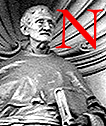[In the passages quoted below I have bolded the names of prophets to make finding them easier. See below for Victorian stained glass depicting Old Testament prophets. — George P. Landow]

ewman opens the sermon entitled “Jeremiah, a Lesson for the Disappointed” by pointing out that “the Prophets were ever ungratefully treated by the Israelites, they were resisted, their warnings neglected, their good services forgotten.” Still, he adds, “there was this difference between the earlier and the later Prophets; the earlier lived and died in honour among their people,—in outward honour; though hated and thwarted by the wicked, they were exalted to high places, and ruled in the congregation.” In support of his point, he explains that “Moses, for instance, was in trouble from his people all his life long, but to the end he was their lawgiver and judge.” The lives of both Samuel and David, who died a king, show the same pattern. “But in the latter times, the prophets were not only feared and hated by the enemies of God, but cast out of the vineyard,” and Newman argues that this changing narrative arc of their lives plays a role in preparing for Christ as succeeding prophets become more precise types of Him. In other words, “as the time approached for the coming of the true Prophet of the Church, the Son of God, they resembled Him in their earthly fortunes more and more; and as He was to suffer, so did they.
Moses was a ruler, Jeremiah was an outcast: Samuel was buried in peace, John the Baptist was beheaded. In St. Paul's words, they "had trial of cruel mockings and scourgings, yea, moreover, of bonds and imprisonment. They were stoned; they were sawn asunder, were tempted, were slain with the sword; they wandered about in sheepskins and goatskins, being destitute, afflicted, tormented; of whom the world was not worthy; they wandered in deserts, and in mountains, and in dens and caves of the earth” [Hebrews xi. 36-38].
Of these, Elijah, who lived in the wilderness, and the hundred prophets whom Obadiah fed by fifty in a cave, are examples of the wanderers. And Micaiah, who was appointed the bread of affliction and the water of affliction by an idolatrous king, is the specimen of those who "had trial of bonds and imprisonment." Of those who were sawn asunder and slain with the sword, Isaiah is the chief, who, as tradition goes, was by order of Manasseh, the son of Hezekiah, sawn asunder with a wooden saw. And of those who were stoned, none is more famous than Zechariah, the son of Jehoiada, "who was slain between the temple and the altar” [Matthew xxiii. 35].
Newman claims that “of all the persecuted prophets Jeremiah is the most eminent,” because “we know more of his history, of his imprisonments, his wanderings, and his afflictions,” and therefore “he may be taken as a representative of the Prophets; and hence it is that he is an especial type of our Lord and Saviour.” Of course, “all the Prophets were types of the Great Prophet whose way they were preparing; they tended towards and spoke of Christ. In their sufferings they foreshadowed His priesthood, and in their teaching His prophetical office, and in their miracles His royal power.” However, because the Bible provides more details of the life of Jeremiah, he “is the most exact type of Christ among them.” Having stated that Jeremiah is therefore the closest, most exact, most elaborate type of Christ, Newman, who seems to have emphasized more than we wanted, immediately qualifies and in part retracts his exaggeration by adding “that is, next to David, who, of course, was the nearest resemblance to Him of all, as a sufferer, an inspired teacher, and a king. Jeremiah comes next to David.” He then again qualifies his initial praise: “I do not say in dignity and privilege, for it was Elijah who was taken up to heaven, and appeared at the Transfiguration; nor in inspiration, for to Isaiah one should assign the higher evangelical gifts.” Jeremiah, it turns out, is most like Christ only “in typifying Him who came and wept over Jerusalem, and then was tortured and put to death by those He wept over.” He concludes this opening part of his sermon by drawing parallels between Christ and Old and New Testament prophets in a way that makes clear that types are always only partial prefigurations of Christ, so that And hence, “when our Lord came, while some thought Him Elijah, and others John the Baptist, risen from the dead, there were others who thought Him Jeremiah.”



Left: Enoch, Isaiah, and Malachi designed by William Butterfield. All Saints, Margaret Street, London. Middle: Melchizedec Right: David. Both designed by Percy Bacon Brothers. St John the Baptist, Holland Road, Kensington. [Click on images to enlarge them.]




Left: David and Solomon. Middle: Noah and Moses both designed by Bell and Beckham. Right: Ezekiel and Daniel. Isaiah and Jeremiah. Both designed by Heaton, Butler and Bayne. All four in St. Mary Magdalene, Enfield, Middlesex. [Click on images to enlarge them.]
Bibliography
Newman, John Henry. “Jeremiah, a Lesson for the Disappointed.” Parochial and Plain Sermons. Vol 8. London: Longmans, Green, and Co., 1891. Project Gutenberg [eBook #24284] online transcription which Al Haines produced.
Last modified 26 June 2018